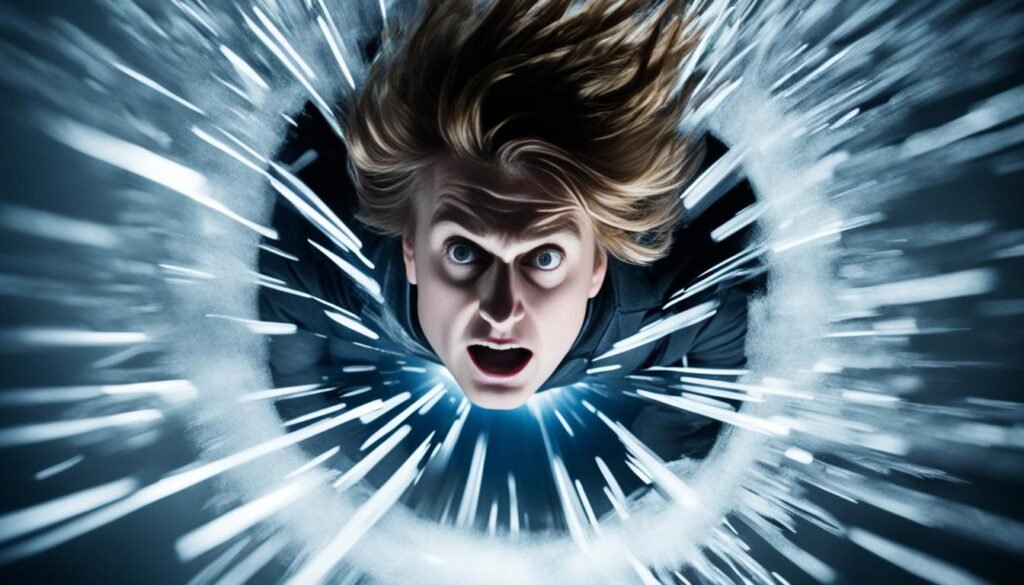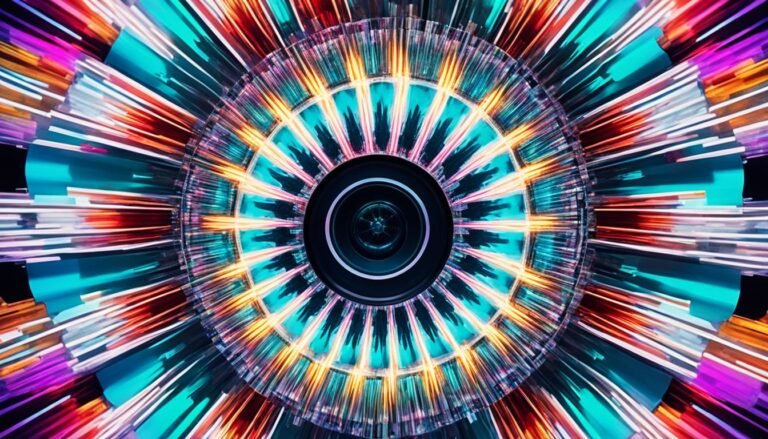Boult Newly Launched Z20 Truly Wireless Bluetooth Ear Buds with 51H Playtime, Zen™ Calling ENC Mic, Made in India, Low Latency Gaming, Rich Bass Drivers, TWS Earbuds Bluetooth Wireless (Pine Green)
₹799.00 (as of April 6, 2025 21:18 GMT +05:30 - More infoProduct prices and availability are accurate as of the date/time indicated and are subject to change. Any price and availability information displayed on [relevant Amazon Site(s), as applicable] at the time of purchase will apply to the purchase of this product.)The film world is changing fast, thanks to new film techniques. These changes have not just affected how movies are made. They’ve also changed the look and feel of movies, creating a new way of telling stories visually.1
Cinematography is key in this evolution. It’s the skill of capturing moving images on film or digitally. It uses things like camera movements, lighting, and composition to make scenes that pull us into the story. Cinematographers are always finding new ways to make movies, leading the way in filmmaking.
Key Takeaways
- The film industry has undergone a revolutionary transformation driven by groundbreaking cinematography techniques.
- Cinematography is the art of capturing moving images, involving elements like camera movement, framing, lighting, and composition.
- Cinematographers have continuously pushed boundaries, innovating techniques, and pioneering new visual styles.
- Digital technology has led to easier manipulation of image quality, resolution, and post-production workflows.
- CGI and visual effects have become integral to creating fantastical worlds and large-scale action sequences.
The Dawn of Digital Cinematography
Digital cameras have changed film production in a big way, leading to amazing innovative cinematography and groundbreaking visual effects. For example, George Lucas’ “Star Wars Episode II: Attack of the Clones” shot in 2002 was a milestone. It was the first big film completely shot with digital cameras.
Tools like the Sony HDW-F900 gave filmmakers more flexibility and control. This change made creating films more open to everyone, not just big studios. They democratized film production.2
The Advent of Digital Cameras in Film Production
Soon after, digital cameras became popular with indie filmmakers. They opened up new ways to tell stories, like in Danny Boyle’s “28 Days Later” from 2002. This film really pushed the boundary-pushing directing and experimental film styles.
It changed how stories were shown on the big screen, transforming the very nature of visual storytelling.2
High-Definition Filmmaking: A New Standard
The move to digital cinema also brought in the era of high-definition filmmaking. By 2017, 4K digital cameras were just as good as old 35mm film. This step forward allowed filmmakers to create even more stunning visuals.
It helped make immersive filmmaking and cutting-edge camera work possible. Now, filmmakers have more ways to tell their stories in creative and exciting ways.3
Pushing Boundaries: Innovations in Lighting and Post-Production

Lighting’s role in movies has changed with the digital age. Now, with HDR, films like “Blade Runner 2049” (2017) create stunning looks. Thanks to LED technology, lighting in filmmaking has never been more versatile.4
Lighting in the Digital Age
LEDs, especially the Litepanels Astra series, are changing how films are lit. They offer precise color and light settings for cinematographers.4 Movies such as “Blade Runner 2049” (2017) show how HDR lighting can make scenes look amazing.4
Post-Production in the Digital Era
Post-production has also gotten better with digital tools. Films like “Sin City” (2005) have used these tools to perfectly match their comic book beginnings.4
Color Grading and Visual Effects: A Digital Revolution
Color grading has advanced in movies like “O Brother, Where Art Thou?” (2000). This film was among the first to fully use digital color grading.4 Digital filmmaking has transformed visual effects, seen in works like “Life of Pi” (2012). In this movie, fully digital characters amazed audiences.4
Revolutionary Film Techniques: Transforming Visual Storytelling

The Emergence of Digital Cameras
Digital cameras changed the game in film production.5 They gave filmmakers brand new ways to tell stories. For example, in 2002, “Star Wars Episode II: Attack of the Clones” and “28 Days Later” used digital cameras. This showed us films could look very different, kicking off a new era in cinema.5
The Evolution of Lighting Techniques
Digital cinematography also reimagined how lighting is used. With HDR’s arrival, films like “Blade Runner 2049” got to play with light in amazing ways.5 Another big change was the introduction of LED lights. Now, cinematographers have more control over color and brightness than ever before. This makes their scenes even more dazzling.5
The Impact of Color in Cinema
Color isn’t just pretty; it’s a powerful storytelling tool today.56 Directors like James Cameron and Stanley Kubrick have used it to shape how we feel and what we see in their films.6 Their works have shown us how deeply we connect with stories when color is used right.
The Rise of Digital Cinematography: Breaking Boundaries
In the late 20th and early 21st centuries, filmmaking changed a lot. The arrival of digital technology transformed how movies were made. Digital cameras gave filmmakers new possibilities. They could easily change image quality, resolution, and how they edited their films after shooting.1 This change brought us amazing things. Now, we can see fantastical creatures, epic landscapes, and big action scenes like never before. Thanks to digital effects, movies look more real and exciting.
Visual Effects: Pushing the Limits of Imagination
Digital cinematography has made visual effects better than ever. It lets filmmakers turn their wildest dreams into real scenes. Just think of the remarkable work in “Life of Pi” from 2012 or the unique look of “Sin City” in 2005. Digital tools have changed how we tell stories with visuals.7
The Transition to Digital Cinematography: Embracing Innovation
Moving to digital filmmaking has seen big steps forward. “Star Wars Episode II: Attack of the Clones” was a key moment in 2002, shot all-digital. Other films, like “Collateral” in 2004 and “Blade Runner 2049” in 2017, have continued this progress in quality and style.7 Digital cameras have also made making movies easier for independent filmmakers. Films such as “28 Days Later” in 2002 by Danny Boyle show this well, opening doors for more creatives to share their stories.
In recent years, new technologies have made filmmaking even more exciting. Things like high dynamic range (HDR) imaging and virtual production have changed the game. Now, storytelling is more intertwined with animation and technology than ever before.1 This shift, combined with the increase of digital platforms, has made the film world richer and more diverse. It has allowed for new voices and stories to be told, reaching a wider audience.1
The digital age in filmmaking is here to stay, bringing new challenges and opportunities. Some of these challenges include piracy and ensuring our digital work is safe. Yet, with these challenges comes great potential. Digital filmmaking has truly transformed our experience with movies and storytelling. It has become an essential part of where the future of filmmaking is headed.1
Pioneering the Future of Filmmaking
Filmmaking is changing fast, thanks to new technologies. High Dynamic Range (HDR) and real-time rendering are making movies look more real than ever. This change makes it hard to tell what’s live-action and what’s not.
Technological Breakthroughs in Film: Pioneering New Frontiers
Digital platforms are giving small filmmakers big opportunities. They’re letting new voices join the film world. With these tools, filmmakers are free to create in fresh ways. They use new effects and methods to catch the eye of viewers all over the world.
The story of film starts with the Lumière brothers and their portable cameras.8 Georges Méliès then amazed people with special effects. With time, filmmaking saw big changes. Color and sound were added, forever altering the industry.
Disney’s multiplane camera and Pixar’s computer graphics broke new ground in animation. They set the stage for classics like “Toy Story”8. These advancements forever altered how animated movies were made.
The partnership between Disney and Pixar brought digital coloring to life8. Movies like “Toy Story” are known for this incredible visual style. Performances in films, such as “Avatar,” were enhanced thanks to new capture techniques.
The future of film is full of endless chances for creativity. “Avatar” and “Ready Player One” show us what’s coming9. The movie industry is ready for more groundbreaking effects and stories that everyone will love.
Current Trends and Future Outlook in Visual Storytelling
The way we tell stories through visuals is always changing. Today, filmmakers are using new tricks to draw us into their worlds like never before. Innovations such as HDR imaging, virtual shooting sets, and instant image processing have made filmmaking more exciting than ever. They mix live-action with animation in clever ways.1
Current Trends in Cinematography
Great directors like Stanley Kubrick and Alfred Hitchcock are known for their unique camera work and storytelling. They showed us new ways to look at movies. With the help of digital platforms today, more voices are heard in the film world. This means lots more stories for us to watch, from people of all backgrounds.1
Innovative Cinematography Techniques
CGI has taken over the big screen, creating things we never thought we’d see. Movies now have everything from flying dragons to entire worlds made from scratch. This has made films more engaging and imaginative than ever before.1
Making videos is no longer just for big studios. Thanks to smartphones, anyone with a good idea can film it. New devices make shooting videos as professional as using an expensive camera. This has changed the way films are made, giving a chance to everyone who wants to tell a story.10
For filmmakers, mobiles have opened doors to a new kind of creativity. Movies filmed only on phones are now getting famous. Films like “Tangerine” and “Unsane” prove you don’t need costly equipment to make something great. This has made filmmaking more diverse and exciting than ever.
Conclusion
Digital cinematography has changed the film world. It has affected everything from effects to how movies are made.11 Using technology keeps improving how films look. It lets creators try new things, making movies better for us all.11
The path of cinematography forward is full of chances for creative expression and artistic exploration.12 Exciting tech like 3D effects and 4K-8K resolution is changing how we see films. It brings us closer with immersive visuals and advanced cinematic effects.11
In 1895, the Lumière brothers amazed the world with 450 moveable cameras.12 Pixar, famous for its computer graphics, joined Disney in 2006 for 7.4 billion dollars. They worked together on things like the CAPS system for coloring animations.12 With chroma key technology, filmmakers now use 3D animation and computer-generated graphics for movies. this made hits like The Matrix, The Lord of the Rings, 300, and Avatar.12
Source Links
- https://filmustage.com/blog/cinematographys-aesthetic-evolution/
- https://www.bfi.org.uk/sight-and-sound/features/attack-zeros-ones-early-years-digital-cinema-told-david-lynch-miranda-july-michael-mann-more
- https://en.wikipedia.org/wiki/Digital_cinematography
- https://filmustage.com/blog/digital-cinematography-a-new-era-in-the-evolution-of-filmmaking
- https://ken-aguado.medium.com/visual-storytelling-in-film-and-television-4f2d176c17cf
- https://www.thecollector.com/narrative-film-techniques-you-should-know/
- https://filmustage.com/blog/digital-cinematography-a-new-era-in-the-evolution-of-filmmaking/
- https://www.bbvaopenmind.com/en/technology/innovation/7-advances-in-technology-that-have-revolutionized-the-film-industry/
- https://filmustage.com/blog/unfolding-the-future-of-film-technology-key-trends-to-watch/
- https://www.ecgprod.com/the-rise-of-mobile-filmmaking/
- http://raindance.org/how-advanced-technology-is-revolutionising-filmmaking
- https://www.bbvaopenmind.com/en/technology/innovation/7-advances-in-technology-that-have-revolutionized-the-film-industry







0 Comments